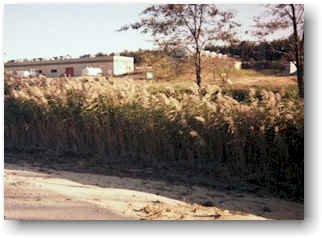Invasive Plants

Common reed (Phragmites australis)
BNL has programs to manage and to control undesirable species. An example, is the invasive species phragmites (Phragmites australis), which is known to destroy native vegetation along water bodies and can potentially threaten endemic aquatic species.
Common reed is a tall perennial wetland grass ranging in height from three to thirteen feet. Strong leathery horizontal shoots, called rhizomes, growing on or beneath the ground surface give rise to roots and tough vertical stalks. These stalks support broad sheath-type leaves that are one-half to two inches wide near the base, tapering to a point at the ends. The foliage is gray-green during the growing season, with purple-brown plumes appearing by late June. The plant turns tan in the fall and most leaves drop off, leaving only the plume-topped shoot. It can grow in water several feet deep, or on the shores, and can cover large areas. It is found in swamps and along lake shores, and canals. Note: Phragmites australis is a native plant of Long Island. It is, however, invasive to BNL site and therefore, should be controlled.
Common invasive and/or non-native plants at BNL
Listed in alphabetical order by scientific name
| Common Name | Scientific Name |
| Mugwort | Artemisia vulgaris |
| Japanese bittersweet | Celastrus orbiculatus |
| Japanese honeysuckle | Lonicera japonica |
| Common reed | Phragmites australis |
| Japanese Knotweed | Polygomella articulata |
| Black locust | Robinia pseudo-arcaci |
General information about invasive plants
Invasive plants have been called non-natives, aliens, exotics, non-indigenous harmful species, weeds, and a host of other names. All of these definitions incorporate a basic concept; invasive plants are plants that have been introduced into an environment in which they did not evolve and thus, usually have no natural enemies to limit their reproduction and spread. Whether plants are transported across an ocean to a new country, across a mountain range into a new valley, or from an infested farm to a non-infested farm, the result is often the same; their fast growth characteristics and high reproductive rates allow them to "invade" the new habitats. Invasive plants do not constitute a separate biological category. They do have characteristics that permit them to rapidly invade new area and outcompete native plants for light, water, and nutrients. Some of these characteristics are included in the following list:
- Early maturation
- Profuse reproduction by seeds and/or vegetative structures
- Long life in the soil
- Seed dormancy ensures periodic germination and prevents seedlings from sprouting during unfavorable conditions
- Adaptations for spreading with crop seeds, by natural agents, or by humans
- Production of biological toxins that suppress the grow of other plants
- Prickles, spines, or thorns that can cause physical injury repel animals
- The ability to parasitize other plants
- Seeds that are the same size and shape as crop seeds, which makes cleaning difficult
- Roots or rhizomes with large food reserves
- Survival and seed production under adverse environmental conditions
- High photosynthetic rates
According to Rejmanek (1996), invasive plants tend to have small seed size, a short juvenile period, and a relatively short interval between seed crops that produce a high number of seeds. For more information refer to the Invasive Plants Fact Book.
References:
- Naidu, J.R.; Brookhaven National Laboratory Wildlife Management Plan, September 22, 1999.
- United States Department of Agriculture, Plant Database; http://plants.usda.gov.
- Westbrooks, Randy G., 1953; Invasive plants: changing the landscape of America: fact book/ [senior author, Randy Westbrooks]. Washington, D.C.: Federal Interagency Committee for the Management of Noxious and Exotic Weeds, 1998.


